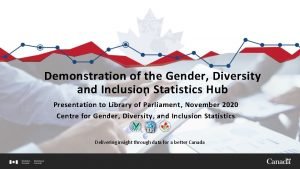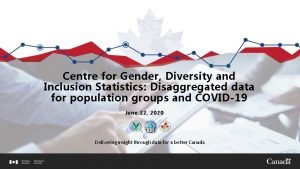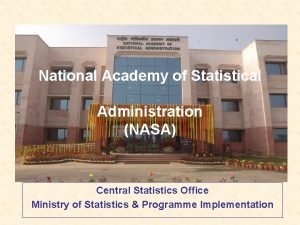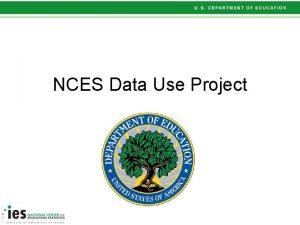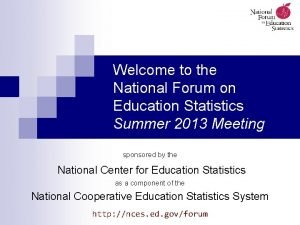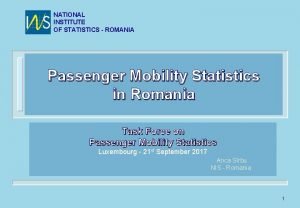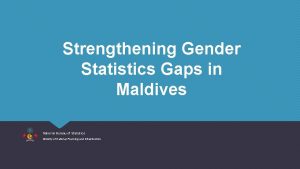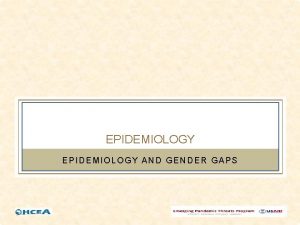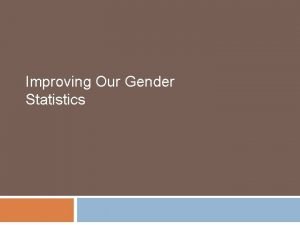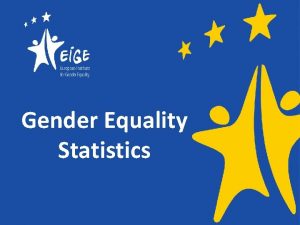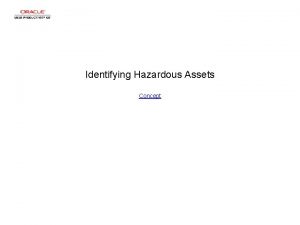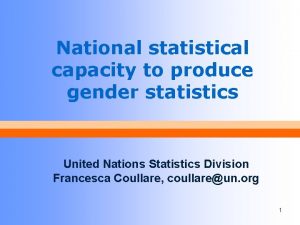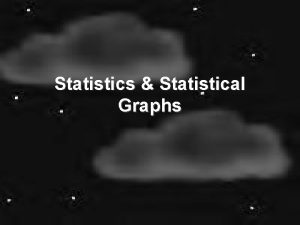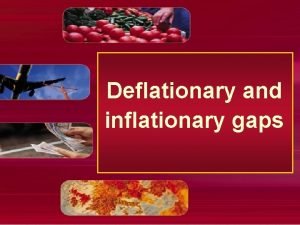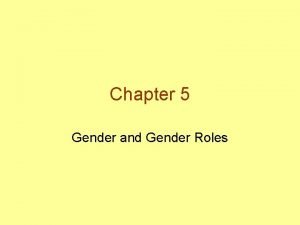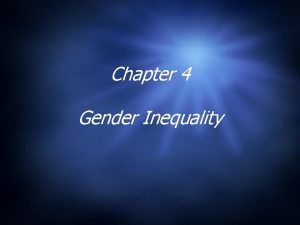IDENTIFYING GENDER STATISTICS GAPS IN THE NATIONAL STATISTICAL


























- Slides: 26

IDENTIFYING GENDER STATISTICS GAPS IN THE NATIONAL STATISTICAL SYSTEM A FRAMEWORK Liliana Suchodolska PARIS 21 17 th of May 2019 UNECE Work Session on Gender Statistics

2 Outline 1. Project background and rationale 2. Framework for Identifying Gender Statistics Gaps 3. Questionnaire 4. Application 5. Next steps

1 BACKGROUND

4 PARIS 21 - Partnership in Statistics for Development in the 21 st Century • facilitates statistical capacity development, • advocates for the integration of reliable data in decision making, • co-ordinates donor support to statistics, • encourages and assists low-income and lower middle income countries to design, implement, and monitor a National Strategy for the Development of Statistics (NSDS).

5 UN Women “Making Every Woman and Girl Count” - ‘Women count’ • technical and financial support to countries to improve the production and use of gender statistics in order to monitor the implementation of gender equality commitments in the 2030 Agenda. • Project implemented between 2016 and 2020. • national assessments conducted in Bangladesh, Colombia, Kenia, Nepal, Tanzania and Uganda

6 UN Women-PARIS 21 cooperation Project activities • Improvement in co-ordination and planning for gender statistics: • development of an assessment framework to identify gender statistics gaps using PARIS 21 tools, • gender mainstreaming of the NSDS in 9 countries • gender statistics module in NSDS Guidelines. • Improvement in data dissemination and communication of gender statistics • Reporting the use of gender data and its value • Reporting of financial resources for gender statistics

2 FRAMEWORK FOR IDENTIFYING GENDER STATISTICS GAPS

8 Framework to identify gaps in gender statistics Review of gaps by looking at the national statistical system, using: Ø Questionnaire for assessing the statistical capacity Ø PARIS 21 tools and methodologies (CD 4. 0, ADAPT, STEP) Ø Mainstreaming gender statistics in the NSDS

9 Identifying gender statistics gaps: What kind of “gaps”: ØMain focus: capacity of the national statistical system but look at in a very granular way; ØGaps relating to data (missing sex-disaggregation of indicators), low frequency of dissemination, the difference between users’ demand vs. producers’ supply

10 Rationale behind the new assessment • Persisting underreporting of gender statistics for monitoring of the Minimum Set of Gender Indicators and achieving the 2030 Agenda; • Previous gender statistics assessments identified • the importance of strengthening national capacity and a need for more guidance relating to institutional arrangements for gender statistics; • the need for a more comprehensive and in-depth analysis of the reasons behind the underreported and poor quality gender statistics.

11 The new assessment Framework 1) Proposes new ways of data gaps assessment, using tools that facilitate: • Identification of data gaps (connects data demands to data inventories and sources, checks compliance of available data). • Mapping data demands (inventories data demanded by key national, regional and global policies) • Data planning (monitors implementation progress and institutional bottlenecks) • Visualizing complex findings for better understanding (tailor-made reports) PARIS 21 ADAPT (Advanced Data Planning Tool)

12 The new assessment Framework 2) Uses new approach to analyse the statistical capacity Capacity Development (CD 4. 0) • Lens to look at the NSS and its capacity to collect, produce, analyze and disseminate high quality and reliable statistics and data to meet users’ needs: • Uncovers different types of stakeholders and interactions between them (for instance organization's reputation related to its communication) • Enables a more granular approach: identifying smaller dimensions allows for a more in-depth assessment.

13 Targets Levels Source: Proposing a Framework for Statistical Capacity Development 4. 0, PARIS 21, 2018 PARIS 21 Capacity Development 4. 0 framework matrix

14 Capacity mismatch between statistical assessment and country priorities Source: Statistical Capacity Development Outlook 2019, results based on the Joint Survey on New Approaches to Capacity Development

15 Existing assessments The coverage of existing assessments or frameworks focus only on the systemic level of statistical capacity: Ø Underreporting the level of organisation Ø Not addressing the individual level Ø Ignoring the area of “Incentives”

16 When to assess the gender statistics gaps? The assessment should be part of a statistics strategy that bears political weight in order to provide a continual prioritization and funding of gender statistics in the national statistical system. National strategy for the development of statistics (NSDS): - A plan for developing statistical capacity across the entire national statistical system. - A vision for where the NSS should be in five to ten years, setting milestones for getting there. - A comprehensive and unified framework for continual assessment of evolving user needs and priorities for statistics and for building the capacity needed to meet these needs in a more coordinated, synergistic and efficient manner.

17 When to assess the gender statistics gaps? The NSDS is a multi-stage process – addressing the gaps should take place in the DESIGN phase The Assessment tool is meant to be a flexible tool which can be used in different national contexts, it can be applied during the design phase of a new NSDS, but can also be considered during the mid-term review of an existing NSDS.

4 ASSESSMENT QUESTIONNAIRE AND METHODOLOGY

19 Questionnaire • Based on the existing assessments and methodologies (UNSD Global Review of Gender Statistics, UN ESWA Conceptual Framework for the Development of National Gender Statistics Programmes, Agri-Gender Statistics Toolkit by FAO and Assessment of the Status of Gender Statistics by UN Women (Bangladesh). • Complemented by the PARIS 21 STEP questionnaire and the US Census Bureau TASC questionnaire. • 76 questions: open-ended as well as closed with pre-defined categories of answers • organised according to the CD 4. 0 framework (level of system, organisation and individual) and smaller dimensions.

20 Questionnaire guidelines • The Questionnaire is to be filled out by the gender statistics expert in consultation with the NSO focal point, the advisor from the ministry of women and other stakeholders: • • Additional short module with 10 questions for other ministries/agencies producing gender statistics, inquiring about their data collection, dissemination of gender statistics and the coordination of statistical work between the stakeholders. The questionnaire needs to be completed during face-to-face interviews but also plenary consultations if necessary (e. g. workshops) • The assessment will take place in 9 countries between 2019 and 2020. The framework is evolving, using the experience from the piloting phase.

21 Assessment Methodology Duration • 3 to 6 months Main Actors • Gender statistics expert • Focal person at the NSO • Adviser from the ministry of women/gender • NSDS focal person • Other information providers • Validating group

22 Assessment Methodology 1. Desk review of existing country policy documentation and legal frameworks 2. Consultations with the NSO, Ministries and other stakeholders (e. g. civil society organisations) 3. Checking data gaps using the ADAPT 4. Validation of findings 5. Final assessment report 6. Formulation of a gender statistics strategy through a consultative process 7. Inclusion of gender strategy in the NSDS

23 Challenges • A comprehensive assessment is a lengthy process, requires many consultations with multiple NSS stakeholders; • Different country contexts: different degrees of the stakeholder’s involvement in the review; • Inclusion of the gender statistics-related strategy in the NSDS does not guarantee it’s implementation.

5 NEXT STEPS

25 Work in progress • Review group commenting on the framework and the questionnaire; Composed, as of February 2019, of 8 experts from Statistics Finland, UN WOMEN (‘Women count’ team), UNECE, UN ESCAP, WORLD BANK and the OECD. • Currently reaching out to national experts for the review of the 2 nd draft • Q 2 -Q 3 of 2019: piloting of the assessment in the Dominican Republic and Maldives. • Developing guidelines for the implementation of the assessment (final version expected in the Q 4 of 2019).

6 THANK YOU Liliana. Suchodolska@oecd. org
 Identifying and non identifying adjective clauses
Identifying and non identifying adjective clauses Identifying and non identifying adjective clauses
Identifying and non identifying adjective clauses Identifying and non identifying adjective clauses
Identifying and non identifying adjective clauses Strategic gender needs and practical gender needs
Strategic gender needs and practical gender needs Centre for gender diversity and inclusion statistics
Centre for gender diversity and inclusion statistics Centre for gender diversity and inclusion statistics
Centre for gender diversity and inclusion statistics National academy of statistical administration
National academy of statistical administration Introduction to statistics what is statistics
Introduction to statistics what is statistics National forum on education statistics
National forum on education statistics National forum on education statistics
National forum on education statistics National forum on education statistics
National forum on education statistics National shoplifting statistics
National shoplifting statistics National forum on education statistics
National forum on education statistics National forum on education statistics
National forum on education statistics Oman national centre for statistics and information
Oman national centre for statistics and information National institute of statistics romania
National institute of statistics romania Hát kết hợp bộ gõ cơ thể
Hát kết hợp bộ gõ cơ thể Slidetodoc
Slidetodoc Bổ thể
Bổ thể Tỉ lệ cơ thể trẻ em
Tỉ lệ cơ thể trẻ em Gấu đi như thế nào
Gấu đi như thế nào Glasgow thang điểm
Glasgow thang điểm Hát lên người ơi alleluia
Hát lên người ơi alleluia Các môn thể thao bắt đầu bằng tiếng nhảy
Các môn thể thao bắt đầu bằng tiếng nhảy Thế nào là hệ số cao nhất
Thế nào là hệ số cao nhất Các châu lục và đại dương trên thế giới
Các châu lục và đại dương trên thế giới Công của trọng lực
Công của trọng lực




